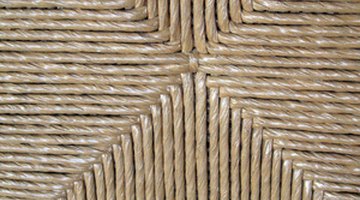How to Replace a Rush Seat in a Hitchcock Chair
Hitchcock chairs, made by the Hitchcock Chair Company in Conn., traditionally use rush seats, which are handwoven seats made of leaves from the common cattail plant. If the seat of your chair has degraded over time, you may need to replace the original seat with a new one.

With some skill and patience, you can weave a new seat at home with the same breed of rush leaves, mimicking the original look of your chair.
Things You Will Need
- Cattail rush leaves
- Hammer
- Tacks
- Varnish
- Cardboard (optional)
Tip
Keep twisting the rush to keep it tight, and make sure that the diameter of each row is the same. If unsure of your skills, practice on an old chair with less value before attempting to replace the seat of your Hitchcock chair.
Warning
You may find it difficult to hold the rush tight and tack it in place. Enlist a second pair of hands to help if necessary.
If your chair is an antique or highly valuable, consider having an expert historical restorer weave the seat for you.
-
Prepare the rushes by soaking them for long enough that they will twist without cracking. Store them together in a cloth bag while you work to prevent them from drying.
-
Tack the first strand of rush to the interior of the left seat rail, about two inches back from the front seat rail. Draw the rush toward you and over the front seat rail, immediately next to where it meets the chair post. Wrap the rush underneath the front rail in a loop, then over the left seat rail, again next to the chair post. Loop the rush underneath the left seat rail, and then draw it across the seat, next to the front seat rail.
-
Wrap the rush over the right seat rail, next to the post. Loop it under the rail, then pull it over the front seat rail, next to the post, and loop it underneath the rail. Tack the rush to the interior of the right seat rail, about two inches back from the front seat rail, and cut off the excess.
-
Repeat the process to form a square around the seat rails, tacking the rush to the interior of the seat rails and continuing from left to right around the chair. Always loop the rush in the same fashion, over and then under the rail. Press each successive row tight against the last.
-
If desired, add cardboard filler between the layers of rush when you have woven about three inches from each corner. Cut the cardboard pieces into trapezoid shapes, with the bottom, longest side of the trapezoids an inch or two shorter than the chair rails. Tuck the corners of the trapezoids into the rushes you have already woven, with the long side parallel to the seat rails. Continue weaving around the exposed cardboard.
-
Continue weaving until you reach the center of the chair. Complete the seat by tacking the end of the rush to the interior of a seat rail.
-
Finish the seat with a light protective varnish.
The Drip Cap
- Hitchcock chairs, made by the Hitchcock Chair Company in Conn., traditionally use rush seats, which are handwoven seats made of leaves from the common cattail plant.
- With some skill and patience, you can weave a new seat at home with the same breed of rush leaves, mimicking the original look of your chair.
- Wrap the rush underneath the front rail in a loop, then over the left seat rail, again next to the chair post.
- Press each successive row tight against the last.
- Continue weaving until you reach the center of the chair.
Writer Bio
Based in southern Indiana, Kristin McFarland has been a freelance writer since 2005. Her work has appeared in the "Indiana Daily Student," "Indianapolis Business Journal," "River Falls Journal," "The Berkeley Daily Planet" and "Rio Grande Sun." McFarland earned a Master of Arts in journalism from Indiana University.
Photo Credits
- woven pattern image by Allen Penton from Fotolia.com
- woven pattern image by Allen Penton from Fotolia.com
More Articles



